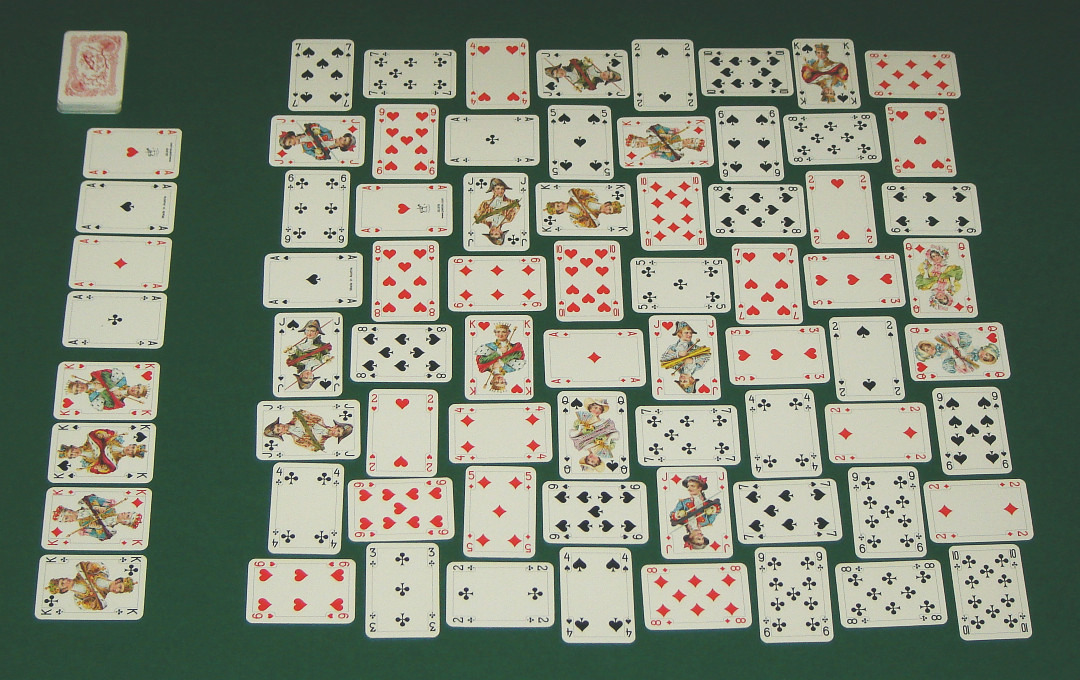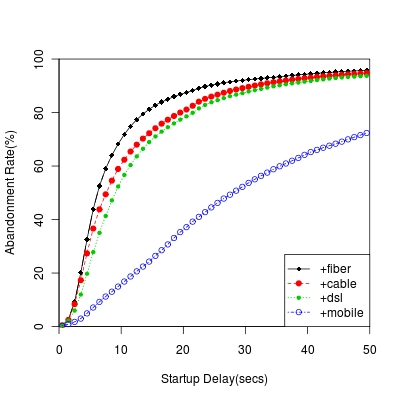|
Spider (solitaire)
Spider is a type of patience game, and is one of the more popular two-deck solitaire games. The game originated in 1949, and its name comes from a spider's eight legs, referencing the eight foundation piles that must be filled in order to win. Rules The main purpose of the game is to remove all cards from the table, assembling them in the tableau before removing them. Initially, 54 cards are dealt to the tableau in ten piles, face down except for the top cards. The tableau piles build down by rank, and in-suit sequences can be moved together. The 50 remaining cards can be dealt to the tableau ten at a time when none of the piles are empty. A typical Spider layout requires the use of two decks. The tableau consists of 10 stacks, with 6 cards in the first 4 stacks, with the 6th card face up, and 5 cards in the remaining 6 stacks, with the 5th card face up. Each time the stock is used, it deals out one card to each stack. Variants Given its popularity, numerous Spider variant ... [...More Info...] [...Related Items...] OR: [Wikipedia] [Google] [Baidu] |
Simple Simon (solitaire)
Simple Simon is a patience or solitaire card game played with a regular 52 cards deck (4 suits of 13 cards each without Jokers). It is a close relative of the well-known Spider Solitaire. It became somewhat popular being featured in some computerized collections of Solitaire card games, but its origins possibly predate its implementation as a computerized game. Rules At the beginning of the play the cards are dealt all facing the player, starting from 3 columns of 8 cards each, and then 7 columns with 7, 6, and so forth cards until 1. A card can be placed on any card on the top of a column whose rank is greater than it by one (with no cards that can be placed above an Ace). A sequence of cards, decrementing in rank and of the same suit, can be moved as one. An empty column can be filled by any card. A sequence of cards from the king down to the Ace - all of the same suit - can be moved to the foundations. The object of the game is to place all four suits in the foundatio ... [...More Info...] [...Related Items...] OR: [Wikipedia] [Google] [Baidu] |
Patience (game)
Patience (Europe), card solitaire, or solitaire (US/Canada), is a genre of card games whose common feature is that the aim is to arrange the cards in some systematic order or, in a few cases, to pair them off in order to discard them. Most are intended for play by a single player, but there are varieties for two or more players. Genre names 'Patience' is the earliest recorded name for this type of card game in both British and American sources. The word derives from the games being seen as an exercise in patience.Parlett (1991), pp. 157–161. Although the name solitaire became common in North America for this type of game during the 20th century, British games scholar David Parlett argues that there are good reasons for preferring the name 'patience'. Firstly, ''patience'' refers specifically to card games, whereas ''solitaire'' may also refer to games played with dominoes or peg and board games. Secondly, any game of patience may be played competitively by two or more players ... [...More Info...] [...Related Items...] OR: [Wikipedia] [Google] [Baidu] |
Unix
Unix (, ; trademarked as UNIX) is a family of multitasking, multi-user computer operating systems that derive from the original AT&T Unix, whose development started in 1969 at the Bell Labs research center by Ken Thompson, Dennis Ritchie, and others. Initially intended for use inside the Bell System, AT&T licensed Unix to outside parties in the late 1970s, leading to a variety of both academic and commercial Unix variants from vendors including University of California, Berkeley ( BSD), Microsoft (Xenix), Sun Microsystems ( SunOS/ Solaris), HP/ HPE ( HP-UX), and IBM ( AIX). The early versions of Unix—which are retrospectively referred to as " Research Unix"—ran on computers such as the PDP-11 and VAX; Unix was commonly used on minicomputers and mainframes from the 1970s onwards. It distinguished itself from its predecessors as the first portable operating system: almost the entire operating system is written in the C programming language (in 1973), which allows U ... [...More Info...] [...Related Items...] OR: [Wikipedia] [Google] [Baidu] |
Patience Video Games
or forbearance, is the ability to endure difficult or undesired long-term circumstances. Patience involves perseverance or tolerance in the face of delay, provocation, or stress without responding negatively, such as reacting with disrespect or anger. Patience is also used to refer to the character trait of being disciplined and steadfast. Antonyms of patience include impatience, hastiness, and impetuousness. Scientific perspectives In psychology and in cognitive neuroscience, patience is studied as a decision-making problem, involving the choice of either a small reward in the short-term, versus a more valuable reward in the long-term. In a 2005 study, common marmosets and cottontop tamarins chose between taking an immediate small reward and waiting a variable amount of time for a large reward. Under these conditions, marmosets waited significantly longer for food than tamarins. This difference cannot be explained by life history, social behaviour, or brain size. It ca ... [...More Info...] [...Related Items...] OR: [Wikipedia] [Google] [Baidu] |
Double-deck Patience Card Games
A double-decker is a vehicle that has two levels for passengers or cargo, one deck above the other. Such vehicles include: * Aerial tramway * Bilevel rail car a rail passenger vehicle consisting of 2 levels * Bombardier BiLevel Coach * Bombardier MultiLevel Coach * Dome car * Double-deck aircraft * Double-deck elevator * Double-decker bus * Double-decker tram * Superliner (railcar) * Autorack (US) or car transporter (UK), a railway vehicle for transporting cars or other road vehicles * Car carrier trailer or auto carrier, a road trailer for transporting cars or other road vehicles * Two-decker is a sailing ship with 2 decks armed with cannon. A double-decker may also refer to: * Double Decker (chocolate bar) * Double-decker sandwich, such as a club sandwich or Dagwood sandwich A Dagwood sandwich is a tall, multilayered sandwich made with a variety of meats, cheeses, and condiments. It is named after Dagwood Bumstead, a central character in the comic strip ''Blondie (comic stri ... [...More Info...] [...Related Items...] OR: [Wikipedia] [Google] [Baidu] |
List Of Solitaires
This is a list of patiences, which are card games that are also referred to as solitaires or as card solitaire. This list is not intended to be exhaustive, but only includes games that have met the usual Wikipedia requirements (e.g. notability). Additions should only be made if there is an existing entry on Wikipedia that they can be linked to. To avoid duplicate pages being created, alternative titles and the names of variants are listed separately (except titles that include little more than the name of the parent game). Games of the patience genre played by more than one player are marked with a plus (+) sign. A * Accordion * Aces and Kings * Aces Square * Aces Up * Acme * Addiction * Agnes * Alaska * Algerian * Alhambra * Amazons * American Toad * Apophis * Appreciate * Acquaintance * Archway * Auld Lang Syne * Australian Patience B * Babette * Backbone * Baker's Dozen * Baker's Game * Baroness * Batsford * Beetle * Beleaguered Castle * B ... [...More Info...] [...Related Items...] OR: [Wikipedia] [Google] [Baidu] |
Solitaire Terminology
Games of patience, or (card) solitaires as they are usually called in North America, have their own 'language' of specialised terms such as "building down", "packing", "foundations", "talon" and "tableau". Once learnt they are helpful in describing, succinctly and accurately, how the games are played. Patience games are usually for a single player, although a small number have been designed for two and, in rare cases, three or even four players. They are games of skill or chance or a combination of the two. There are three classes of patience grouped by object. The most frequent object is to arrange the cards either in ascending sequence (e.g. from Ace to King) or descending sequence. Occasionally both forms of sequence are aimed at in the same game. The card forming the starting point of the required sequence is known as the foundation card and the sequence or family is said to be 'built up' on such card. In some cases foundation cards are picked out and placed in posit ... [...More Info...] [...Related Items...] OR: [Wikipedia] [Google] [Baidu] |
Undo
Undo is an interaction technique which is implemented in many computer programs. It erases the last change done to the document, reverting it to an older state. In some more advanced programs, such as graphic processing, undo will negate the last command done to the file being edited. With the possibility of undo, users can explore and work without fear of making mistakes, because they can easily be undone. The expectations for undo are easy to understand: to have a predictable functionality, and to include all "undoable" commands. Usually undo is available until the user undoes all executed operations. But there are some actions which are not stored in the undo list, and thus they cannot be undone. For example, ''save file'' is not undoable, but is queued in the list to show that it was executed. Another action which is usually not stored, and thus not undoable, is ''scrolling'' or ''selection''. The opposite of to undo is to redo. The redo command reverses the undo or advances ... [...More Info...] [...Related Items...] OR: [Wikipedia] [Google] [Baidu] |
Don Woods (programmer)
Donald R. Woods (born April 30, 1954) is an American hacker and computer programmer. He is best known for his role in the development of the ''Colossal Cave Adventure'' game. Biography Early programming career Woods teamed with James M. Lyon while both were attending Princeton in 1972 to produce the unprecedented, excursive INTERCAL programming language. Later, he worked at the Stanford AI lab (SAIL), where among other things he became the SAIL contact for, and a contributor to, the Jargon File. He also co-authored "The Hacker's Dictionary" with Mark Crispin, Raphael Finkel, and Guy L. Steele Jr."The computer contradictionary" by Stan Kelly-Bootle Work on ''Adventure'' Woods discovered the ''Colossal Cave Adventure'' game by accident on a SAIL computer in 1976. After contacting the original author by the (now antiquated) means of sending an e-mail to crowther@''sitename'', where ''sitename'' was every host listed on ARPANET, he heard back from William Crowther shortly aft ... [...More Info...] [...Related Items...] OR: [Wikipedia] [Google] [Baidu] |
AisleRiot
An open-source video game, or simply an open-source game, is a video game whose source code is open-source. They are often freely distributable and sometimes cross-platform compatible. Definition and differentiation Not all open-source games are free software; some open-source games contain proprietary non-free content. Open-source games that are free software and contain exclusively free content conform to DFSG, free culture, and open content and are sometimes called ''free games''. Many Linux distributions require for inclusion that the game content is freely redistributable, freeware or commercial restriction clauses are prohibited. Background In general, open-source games are developed by relatively small groups of people in their free time, with profit not being the main focus. Many open-source games are volunteer-run projects, and as such, developers of free games are often hobbyists and enthusiasts. The consequence of this is that open-source games often take long ... [...More Info...] [...Related Items...] OR: [Wikipedia] [Google] [Baidu] |
Unix-like
A Unix-like (sometimes referred to as UN*X, *nix or *NIX) operating system is one that behaves in a manner similar to a Unix system, although not necessarily conforming to or being certified to any version of the Single UNIX Specification. A Unix-like Application software, application is one that behaves like the corresponding List of POSIX commands, Unix command or Unix shell, shell. Although there are general Unix philosophy, philosophies for Unix design, there is no technical standard defining the term, and opinions can differ about the degree to which a particular operating system or application is Unix-like. Some well-known examples of Unix-like operating systems include Linux, FreeBSD and OpenBSD. These systems are often used on servers as well as on personal computers and other devices. Many popular applications, such as the Apache HTTP Server, Apache web server and the Bash (Unix shell), Bash shell, are also designed to be used on Unix-like systems. Definition The Open ... [...More Info...] [...Related Items...] OR: [Wikipedia] [Google] [Baidu] |
GNOME
A gnome () is a mythological creature and diminutive spirit in Renaissance magic and alchemy, introduced by Paracelsus in the 16th century and widely adopted by authors, including those of modern fantasy literature. They are typically depicted as small humanoids who live underground. Gnome characteristics are reinterpreted to suit various storytellers and artists. Paracelsus's gnome is recognized to have derived from the German miners' legend about or , the "metallurgical or mineralogical demon", according to Georg Agricola (1530), also called (literal Latinization of ''Bergmännlein'', "mountain manikin") by Agriocola in a later work (1549), and described by other names such as (sing. ; Latinization of German ). Agricola recorded that, according to the legends of that profession, these mining spirits acted as miming and laughing pranksters who sometimes threw pebbles at miners, but could also reward them by depositing a rich vein of silver ore. Paracelsus also called ... [...More Info...] [...Related Items...] OR: [Wikipedia] [Google] [Baidu] |








